

LETTER FROM WILLIE BANKS U.S Olympians President
The Olympic Train Keeps Chugging Along
USOC President Peter Ueberroth, back when he was running the Los Angeles Olympic Organizing Committee, once said that the "Olympic movement is like a moving train, people get on and people get off but the train always moves forward." Recently, there were several changes made in the leadership at the USOC. Charlie Huebner, who has overseen the Alumni Department, was chosen to lead the U S. Paralympics Division Perhaps in this case, to use our earlier analogy, Charlie did not leave the train , he merely moved to another car on the train I want to wish Charlie well in his new position and thank him for the support and dedication he has shown to the U.S. Olympian organization I think the Paralympic organization is lucky to have pried him away.
Fortunately for this train, Charlie's replacement, Jeff Howard, seems just as dedicated and prepared to step in and continue where Charlie left off. A week after Charlie's move, I had a chance to sit down and meet with Jeff, Director of Education and Outreach Programs , who will take over responsibility of overseeing the Alumni Department. In a frank conversation in a little Mexican restaurant near the sunny shores of Solana Beach, California, Jeff and I discussed the future of the United States Olympians and the USOC education and outreach efforts. Fortunately for all ofus , Jeff is a staunch supporter of integrating the U S. Olympians into the many programs and assets of the USOC
Some of the pertinent things which we discussed were the programs that he especially likes to see the Olympians embrace such as the F.L.A .M .E. (Finding Leaders Among Minorities Everywhere) program, as it is rolled out nationally.
As you know, the U.S. Olympians Association officers have been advocating a speakers program for the Alumni After two years of discussions, the program has yet to become a reality. However, maybe because Jeffs background is in communications, hi s support for a speakers program is very strong. He mentioned an exciting new idea for our alumni that will help provide resources for speeches The program would, in essence, provide Olympians a CD to use at elementary and high school appearances that focuses on the Olympic Ideals.
Many programs that we have been working on as a group can be integrated into similar programs that the USOC has been working on: for example media training for U.S. Olympians; an education program that Olympians will help develop and the Athlete Career Program for Olympians who are transitioning from athletics to other endeavors. In addition, Jeff and I discussed a timetable for a U .S. Olympians Reunion. We have been assured that a reunion is in the planning and we both feel confident that by working together we will be able to initiate the first reunion within the next two years. The more I spoke with Jeff the more excited I felt about the future working relationship I hope we can continue to take advantage of this opportunity to work with Jeff (along with Cindy Stinger, of course) to get more involved in supporting the USOC's goals and our own agenda.
Finally, as the "Olympic Movement train " continues to roll down the track, our new conductor has set a good tone for the future of the alumni program While we are excited to have Jeff with us, I want to thank Charlie for his past leadership and support for our program and hope that he will continue to visit us somewhere down the track. To all you Olympians All Aboard!
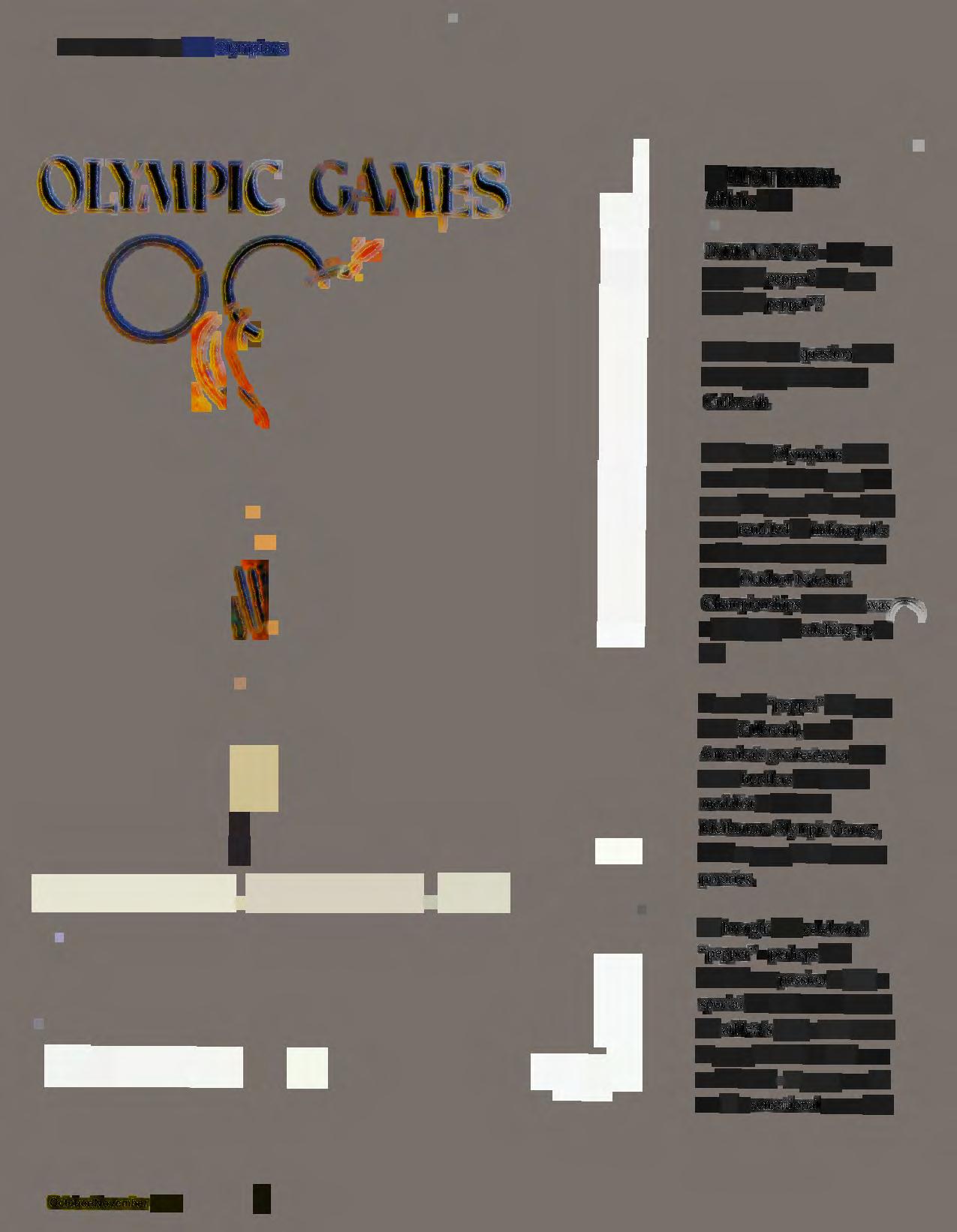 By ELLIOTT DENMAN; Athletics 1956
By ELLIOTT DENMAN; Athletics 1956
INDIANAPOLIS - "Did you bring the pepper? Did you bring the pepper"?
That's the first question Anne Marie Flynn had for Josh Culbreath.
These two Olympians hadn't seen each other for years and years and years , but now they were reunited in Indianapolis at the recent USA Track and Field Outdoor National Championships and there was a huge heap of catching - up to do.
It was the "pepper" that separated Culbreath, one of America's greatest -ever 400meter hurdlers and bronze medalist at the 1956 Melbourne Olympic Games, from so many of his contemporaries.
He brought that celebrated " pepper" - perhaps best defined as a passion to win, a speci a l fire that burned within his athlete's soul, a total desire to prove himself the best man on the track - to every race he ran in a sensational career that



began as a high schooler in Norristown, PA.
Culbreath, who represented Morgan State University and the U.S. Marine Corps, along with the USA, was a shorter man, but he never let that get in the way of his success story in the hurdles races. On top of all his successes in intermediate hurdles races (where the 10 barriers are three feet high), he was also able to run with some of the best over the high hurdles (three feet, six inches).
And he stood tall through the 1950's as one of America's greats. It was 1lenn Davis of Ohio State (in an Olympic- record 50.1 seconds) , Eddie Southern of Texas (50.8) and Culbreath (51.6) who ran 1-2-3 for the USA in the 400 hurdles at the 1956 Melbourne Olympic Games.
The Pan American Games of 1959 in Chicago, the first time the Pan Ams had ever been held in the U.S. , saw Culbreath in even greater form He won the 400 hurdles in 51.2 seconds to set a Pan Am record, and he added a silver on the USA 4x400 relay team that ran a close second to a powerful West Indies Federation team Culbreath had already won a gold in the 400 hurdles at the Pan Am Games of 1955 in Mexico City.
-----Culbreath was a superb runner in flat
racing, too, often duking it out with the best in 440-yard and 600-yard races indoors, and in " quarters" outdoors In all of them, of course, he was sure to "bring the pepper."
So it was natural that Culbreath would "bring the pepper" to Indianapolis , too.
He was there for a grand reunion of the 1956 U.S. Olympic Team that will be forever ranked as one of the most celebrated in American sports
Thus , the track and field phase of those '56 Games was held many months after the traditional American season had ended. But a look at the results would never indicate there were any problems rising back to a late November peak.
The American men won an astounding 15 gold medals , nine silvers and four bronzes. With a total of 24 events in the entire men's phase of the Games , that left just nine events for the rest of history.
Thanks to the efforts of USA Track and Field, America's national governing body for the sport, and USATF's own Alumni Association , 10 members of that 1956 team came to Indy to stroll down a memory-packed lane. The efforts of Alumni A ssociation president Willie Banks, secretary Louise Mead Tricard , vice president Sharieffa Barksdale , and treasurer Phil Raschker, and USATF
staffers made it all happen.
Thus, the track and field


phase of those 156




Games was held many months after the traditional American season had ended.
The Melbourne Games of 1956, which opened on November 22 that year, were both the first Games ever staged in the Southern Hemisphere, and the latest Games held in a calendar year.
the world to win Apart from the St. Louis Olympics of 1904 - which just a few other nations attended - that '56 men's track and field team registered the most dominant performance in modern Olympic history.
The American women of '56 won one gold on the medal stand, and he concluded a victory streak in Olympic long jump commedal (Mildred McDaniel's high jump tri- brilliant Olympic career with a ninth place petition to seven straight Games umph), one silver (long jumper Willye at the 1964 Tokyo Games. White) and one bronze (4xl00 relay).
Mattos , who'd already gone to the 1952 Culbreath termed the Indianapolis reunion "just fantastic " And the other nine who attended agreed fully. Their only regrets
There were hugs and wide smiles all around through the four days of the Indy reunion. The Olympians were introduced to Indy fans and served as very special were that so many of their teammates had medal-presenters to the 2006 national been unable to join them. champions in their specialties. And the warmest of memories were served up each On the men's side, on hand were gold night at Alumni Association gatherings. medalists Tom Courtney (800 meters and 4x400 relay) and Dr. Greg Bell Long (long Culbreath reminded Courtney of his epic jump) , along with triple jumper Ira Davis, 1:45 8 victory over Belgium's Roger pole vaulter George Mattos, SO-kilometer Moens at the 1957 Bislett Games in Oslo, racewalker Elliott Denman, and Culbreath. Norway, and Courtney reminded Culbreath of his
Representing the 1956 women's team were worldKaren Anderson Oldham (javelin) , record Lucinda Williams Adams (100-meter performdash), Connie Darnowski Stoll (80-meter hurdles) and Anne Marie Flynn (high jump)
ance of 50.5 for the 440yard hurdles in the same meet.

The 1959 Pan American Games also saw Adams dominate the women's sprints (with gold medals in the 100, 200 and 4xl00 relay) and Flynn win the high jump. In addition to Culbreath's two medals for the '59 Pan Am men's team, Bell took a silver in the long jump
Dr Bell told of his Melbourne long jump victory, as an "older guy" who'd already put in two years of Army service before entering Indiana
The 1960 Rome Olympics saw Adams University and starting on take a gold in the women's 4xl00 relay the road to a career in denand Oldham place 13th in the javelin. Ira tistry In beating American Davis was a Rome Olympian, too, placing teammate John Bennett, Dr. fourth , just two centimeters shy of a spot Bell continued an American
Helsinki Games in the pole vault as a San Jose State student, re-told the story of the Melbourne vault, where Rev. Bob Richards repeated his 1952 victory to become the very first and still the oneand-only man ever to win consecutive Olympic vault crowns. Mattos placed fourth and, with Richards first and Bob Gutowski second, only the presence of Greece's (and UCLA's) Georgios Roubanis in third averted another American sweep.
Of course, these FiftySixers have had all kinds of other adventures in the years since the Melbourne Games.

A T R I U T E T 0

BOB MATHIAS
0 N E 0 F T H E ALL-TIME G R E A T S
By MIKE MORAN: Colorado Springs Sports Corp.How fortunate our community is to have been the home for six years to a true American hero, Olympic champion Bob Mathias.
As the first U.S. Olympic Training Center director, ~athias welcomed the first .vave of athletes to Colorado Springs in 1977 and ushered in a new era for America's athletes with dreams as big as his when he was a teenage kid in Tulare, Calif. As our nation emerged from World War II with heady optimism and boundless energy, Mathias left the San Joaquin Valley farming town at the age of 17 to win the gold medal in the decathlon in the 1948 London Olympics, the yo ungest man in history to win an Olympic track and field event.
He came back home to parades and applause, then emolled at Stanford, where he was a football and track star. He also won the decathlon title in the 1952 Helsinki Olympics and led Stanford to the Rose Bowl in the same year, returning a kickoff by Southern Cal's Frank Gifford for a touchdown.
Mathias enjoyed stints in movi es and television and served in he U.S. Congress from 1966-74 before assisting Gerald Ford's effort to win the presidency in 1976. A year later, he was named the Director of the Colorado Springs U.S. Olympic Training Center by the United States Olympic Committee, which had http://www.usolympicteam.com

begun to build a facility, now in its 29th year. The training center has helped some 350,000 athletes begin their own Olympic and Paralympic dreams.
Millions of youngsters in post-war America saw Mathias as the shining model of what could be, with hard work and a passion for achievement. On the front of a Wheaties box , no les s !
He was the epitome of the American Dream, and we were fortunate to know him briefly as a colleague and friend in Colorado Springs We watched him help to open wide the possibilities for athletes from small towns like his , as well as the big cities and elsewhere in our nation.
We honored him in 2004 with his induction into the Colorado Springs Sports Hall of Fame. On that evening at the World Arena, as he posed for pictures and signed autographs for a seemingly endless line of kids and adults, we could not have imagined how little time was left.
When Bob passed away recent ly, his friends in Colorado Springs mourned, as did , I am confident, a generation of Americans who saw in this remarkable and humble athlete and public servant, everything that is, and remains, so special about our way of life.
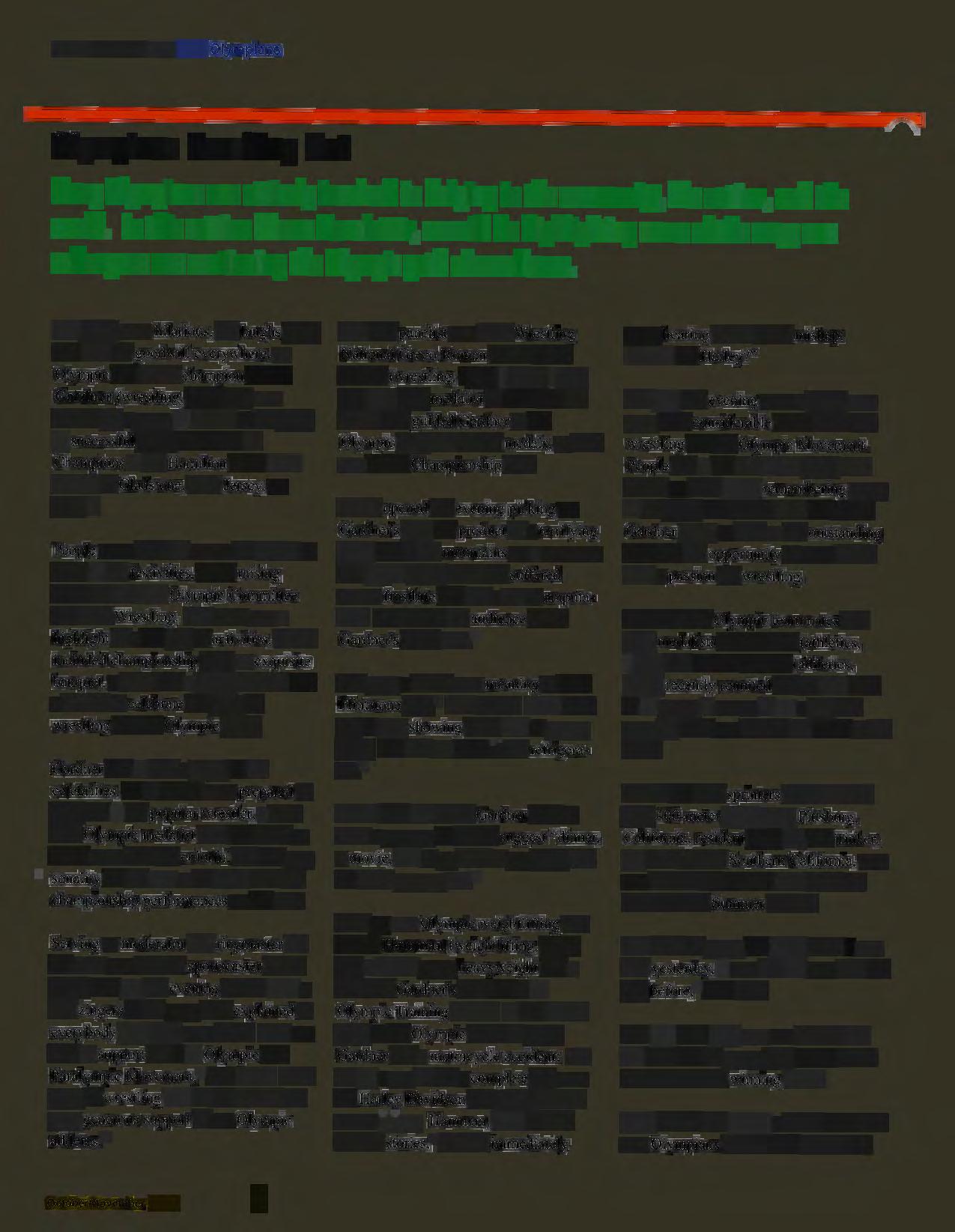
Olympians Reaching Out
Many Olympians are actively involved in helping in the community, the nation, and the world. In this section of our Newsletter, we will be highlighting some of the ways our colleagues are continuing the Olympic path of excellence.
The jokes were hilarious, the laughs plentiful and the goodwill everywhere, as Olympic and World champion Rulon Gardner (wrestling, 2000 , '04) was roasted by a group of friends at the highly successful Night and Drive of Champions at the Hamilton Farm Golf Course in Gladstone, New Jersey, on May 8 .
People came from all across the nation to share in the festivities, while raising funds for the U.S. Olympic Committee and USA Wrestling The roast was a highlight of a full day of activities, which included championship golf, an exquisite banquet, a silent and a public auction and a chance to celebrate the sport of wrestling and the Olympic spirit.
Gardner had to face a panel of six celebrities, all of whom were prepared to poke fun at the popular wrestler, a twotime Olympic medalist who has made as much news with his colorful life and personality off the mat as he made with his championship performances on the mat.
Serving as moderator and ringmaster for the roast was WNBC sportscaster Bruce Beck , who got the evening started with a few zingers of his own, then explained to everybody why they were there. "We are here to support the U.S Olympic and
The first panelist was USA Wrestling
National Greco-Roman Coach Steve Fraser (wrestling, 1984) (coach, 1996, '00, '04) , gold medalist in 1984 and the coach who guided Gardner to his Olympic gold and bronze medals, as well as a World Championship title .
Fraser opened the evening picking on Gardner's feet, the product of a terrifying night lost in the mountains on a snowmobile trip in 2002, where he suffered severe frostbite and lost a toe to amputation. Fraser told the audience about Gardner's "nine toes."
"He gave a whole new meaning to Fred Flintstone feet," said Fraser. "You have got to stop showing those feet to everybody. Put that toe back in the refrigerator."
Fraser said that when Gardner tried to meet a woman, he would suggest "dinner, a movie , and to go back to my place and I'll show you my toe. "
Next up was Olympic weightlifting star Shane Hamman (weightlifting, 2000, '04) a fellow super he avyweight and a friend of Gardner's from the U.S. Olympic Training Center. A few weeks prior to the Olympic Trials in 2004, Gardner had a motorc yc le accident: cut Paralympic Movement," said Beck. "The off by a car, he did a complete flip over sport of wrestling will be the vehicle for his Harley Davidson and barely missed your generous support of our Olympi c athletes."
severe injury. Hamman , used to wild " Rulon stories," reacted immediately
upon hearing of this latest mishap: "How's the Harley ?"
The day and evening were a major success , with considerable funds raised for wrestling and the Olympic Movement. People left at the end of the night with smiles on their faces, remembering many of the jokes and stories from the Rulon Gardner roast , as well as the outstanding food and the opportunity to meet others with a passion for wrestling.
When former Olympic teammates and gold medalists Eddie Hart (athletics, 1972) and Gerald Tinker (athletics, 1972) recently reunited for the first time in 34 years, it was as if not a day had gone by since one handed the baton to the other.
Two of the four sprinters from the winning 400-meter relay team, Pittsburg, California, resident Hart, 57, and Tinker, 55, who lives in Southern California, saw one another for the first time since the 1972 Munich Summer Games.
"It's been 34 years, but gosh , when I saw him yesterday, it was like I'd seen him the day b efore," Hart said.
The day after they saw one ano ther for the first time in years , they talked of the Games and their winning effort.
Hart , Tinker and nearly a dozen other former Olympians shared their stories and
tips with about 200 young athletes age 8 "I really want the kids to know they can to 18 at the inaugural Eddie Hart be successful at whatever they put their Olympian Track Clinic The clinic went minds to ," Hart said. "It's about educafrom 9 a m to 4 p.m. on July 29, 2006, at tion and being viable members of society, the Pittsburg High School Pirate Stadium and making sure they don't give in to track. drugs, violence and peer pressure."
"One thing about Eddie hasn't changedhis quick smile," Tinker said. "That's the impression I always have of him . Everybody's looking for the edge. He's got that smile."
Hart , who was considered a favorite for the gold medal in the 100 meters and one of the most experienced anchor runners in the world , said Tinker broke the 400meter race wide open.
"He almost ran over me . He was ready to go," Hart said. " He was still charged JP after the race, doing high knee raises ."
Tinker recalled how the sprinters took out another member of the team, Larry Black (athletics , 1972) , to celebrate his silver medal in the 200-meter race. After a night out in Munich, they were escorted back to the team's compound by a U.S. Marine. They then learned about the Israeli athletes kidnapped and later murdered by Palestinian militants
Black, who was Tinker's first cousin, died from an aneurysm in February. Hart and Tinker couldn't get in touch with Robert Taylor (athletics, 1972) the fourth member
For the clinic, Hart recruited all the Olympians who competed in the different Games from 1964 to 1992, making phone calls and calling in favors. Hart said his notivation was to bring in role models to an event all of Pins burg could be proud of and benefit from.
Along with coaching , the clinic had classroom time and host speakers from UC Berkeley, JFK University and Los Medanos College in Pittsburg to talk about what's needed academically and financially to go to college.
Jeb Bell , President of the Equipment Controls Company, sent the following testimonial:
I would like to bring to your attention the efforts of 1996 Olympian Darrick Heath (team handball , 1996). Darrick, the USA's Michael Jordan of team h andball, has continued to support the sport in this country through his tireless efforts to coach and teach youth of all ages. Darrick visits numerous Boys' and Girls' Clubs throughout the Atlanta area as well as helping make sure the annual Cobb Cup (youth team handball tournament) is a success.
Darrick also coaches adult men's and women's teams in a tireless effort to promote the sport. Through it all, Darrick presents the persona that the Olympic spirit is all about. In a day and age where we hear negative press about athletes, Darrick rises above the crowd. I am proud to have my son learn from and play under Darrick's tutelage. I am even more proud to call him friend.


Tyson Foods, Inc. teamed up with Olympic star gymnasts Shannon Miller (gymnastics, 1992, '96), John Roethlisberger (gymnastics, 1992, '96, '00) and John Macready (gymnastics, 1996) at the Community Partners for Youth in St. Paul, Minnesota, to announce a 30,000-pound donation of much needed protein to the Second Harvest Heartland network
The donation is part of Tyson's ongoing commitment to hunger relief and national sponsorship of America's Second Harvest. Since 2000, Tyson has donated more than 38 million pounds of protein to more than 400 hunger relief organizations nationwide.
Young people age 7 to 13 had the chance to learn swimming from an Olympic gold medalist this summer at the Richmond (California) Swim Center Bill Woolsey (swimming , 1952 , '56), a gold medalist in Helsinki in the 800-meter freestyle relay and a silver medalist in the same event four years later in Melbourne, taught basic water safety.
" The whole idea is to get them to learn the basic movements, and from there , we can get into competitive swimming, if that's what they want," said Woolsey, who taught aquatics for about 40 years in his native Hawaii, where he also was active with the Special Olympics He has also helped several schools in Japan develop swimming programs and teaches swimming to disabled children.
"We're talking about health and safetysafety first, he said." "The idea is for them to be able to move from point to point to save themselves. That's the ultimate goal. "

USO( UNVEILS NEW POOL FOR ATHLETES
The United States Olympic Committee announced the opening of a new U.S. Olympic Outdoor Training and Recreational Pool for athletes at the U.S. Olympic Training Center in Colorado Springs , Colo. After being closed for 10 years, America's athletes will now benefit from a state -of-the art swimming pool donated by Hampton Hotels, a member hotel of U.S. Olympic & Paralympic Team sponsor, Hilton Hotels Corporation
The $225,000 pool will be utili zed each year by more than 2,500 athletes and coaches. The pool was unveiled to athletes on Friday, September 29 with an official U.S. Olympic Outdoor Training and Recreational Pool Grand Opening Pool Party.
Improving the living and training environment for America's athletes is at the center of th e Hilton Family of Hotels partnership with the USOC. The new Training and Recreational Pool came to the athletes as a result of a visit from a group of Hampton Hotels executives.
The group from H ampton also learned that in a recent survey conducted by the USOC , the No. 1 request by athletes to enhance their living conditions was for an outdoor training and recreation pool.
"America's athletes continue to benefit from the generosity and commitment of the Hampton brand and the Hilton Family of Hotels ," said USOC Managing Director of A thl ete Facilities and Services, Mike English. "The USOC is committed to providing athletes living and training at its Olympic Training Centers the best possible environment in order to enhance athlete morale and provide the best training possible."
The new pool is already an anticipated hot -sp ot for athletes. "We're ecstatic about the outdoor pool. Everybody that lives he re can't wait to be among the first to dive-in ," said Yewki Tomita, a resident gymnastics athlete. "Not only are we excited to have a place to train outside but we're already talking about how the new Hampton Rec. Pool will be the cool place to been seen training and kicking-back in the summertime."
"Hampton is excited to be part of the support system that helps aspiring Olympians excel. We think that it is important for athletes to have a place to relax and rejuvenate during their downtime ," said Phil Cordell, senior vice president of H ampton brand management. " Thi s new Outdoor Training and Recreational Pool is the result of the passion and commitment that our company has for helping the Olympic Movement in America flourish ."
Colorado Olympians
U.S. OLYMPIAN CHAPTERS
Did you know that the U.S. Olympians have regional chapters throughout the country? Look for updates on chapter happenings in future issues of The Olympian! Ifyou would like to find out what is happening in your area, contact:
President: Gene Kotlarek (skiing, 1960, '64) (303)-807-3911
Florida Olympians
President: Jim Millns (figure skating, 1976) (813) 926-5955
Georgia Olympians
President: TBD
Hawaii Olympians
President: Richard "Sonny" Tanabe (swimming, 1956) (808) 735-1088
Indiana Olympians
President: Ollan Cassell (athletics, 1964) (317) 466-0444
Midwest Olympians
President: Willye White (athletics, 1956, '60, '64, '68, '72) (773) 651-8267
National Capital Arca Olympians
President: Arlene Limas (taekwondo, 1988) (540) 720-1988
New England Area Olympians
President: TBD
Northern Ca li fornia Olympians
President: Anne Warner Cribbs (swimming, 1960) (650) 856-3200
Oregon Olympians
President: Cl em Eischen (athletics, 1948) (503) 492-2232
Southern California Olympian s
President: Cathy Marino Bradford (canoe/kayak, 1988, '92) (714) 847-5596
Southwest Olympians
President: Sammy Walker (weightlifting, 19 76) (469) 964-8824
Tri-States Olympians
President: Oti s Davi s (athletics, 1960) (201) 392-8448
Utah Olympians
President: Henry Marsh (athl etics, 19 76, '80, '84, '88) (801) 560-8698
Washington State Olympians
President: John Stillings (rowing, 1984) (206) 440-0708
No chapte r in your are a? Interested in starting a chapter? Contact the U.S Olympians Association office at (800) 717-7555 for detai ls.

http://www.usolympicteam.com
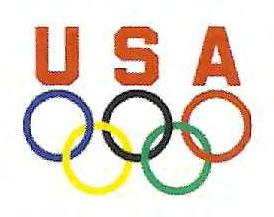
gsA RTHLETE Q9 CAREER
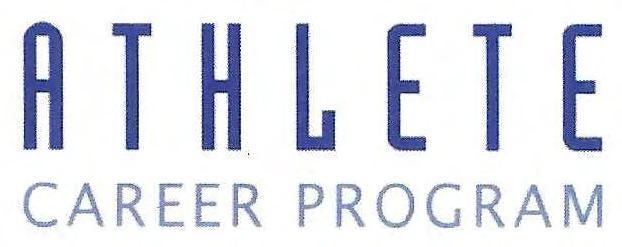
PROGRAM
Adecca
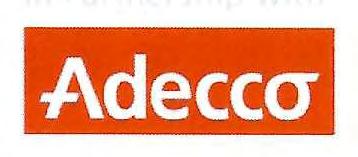
Athlete Career Program Assists Olgmpians, Paral11mpians, and Elite Athletes
In response to the growing need for career-related programs and services among America's Olympians, Paralympians , and elite athletes, the U .S. Olympic Committee (USOC) and the Adecco Group , the USOC ' s Official Career Management Services Supplier, have created the Athlete Career Program (ACP) . The program offers services to Olympians and Paralympians retired from sport as well as currently training elite athletes.
The USOC and the Adecco Group understand that elite athletes ' priority is to focus on their sport career. However, we a lso know that there comes a point in life when individuals need to make decisions about their post-athletic careers and their future. Some Olympians or Paralympians who have been retired from sport for a few years may now be considering yet another career change. Through the ACP , all athletes , both actively training and those retired from sport, can accomplish their objectives.
Developed specifically with athletes in mind, the ACP offers personalized career management resources and services , such as access to a personal career coach, resume assistance, job placement assistance, and a v ariety of seminars that focus on such things as networking, interviewing , or becoming an entrepreneur. These services utilize all three companies of the Adecco Group: Lee Hecht Harrison, Adecco Staffing , and Ajilon.
If you would like more information , would like to coordinate ACP services for a group, or have questions about the program, please call 800-933-4473 , ext. 1.

" What a great program for both athletes retiring from sport and even for those who aren 't If you are indecisive about your future , it gives you things to start thinking about now It's never too soon to start planning ahead!" - Bonnie Blair , Olympian , Speedskating , 1984 , 1988 , 1992, 1994 , 5-time gold medalist , bronze medalist
"The ACP is a great resource for athletes like me who have been retired from sport for sometime, but are still growing professionally. The advice I have received from my personal Adecco career coach was invaluable to me as I planned to expand my business. " - Robert Kaehler , Olympian, Rowing , 1992 , 1996, 2000

"I've always heard about programs like the ACP, but I always "thought" I was too busy to utilize them After going through the program myself, I would tell other athletes that they are missing the opportunity of a lifetime if they don't take advantage of this program!"
- Bill Schuffenhauer , Olympian , Bobsleigh , 2002 Silve r Medalist , 2006


~SA RTHLETE
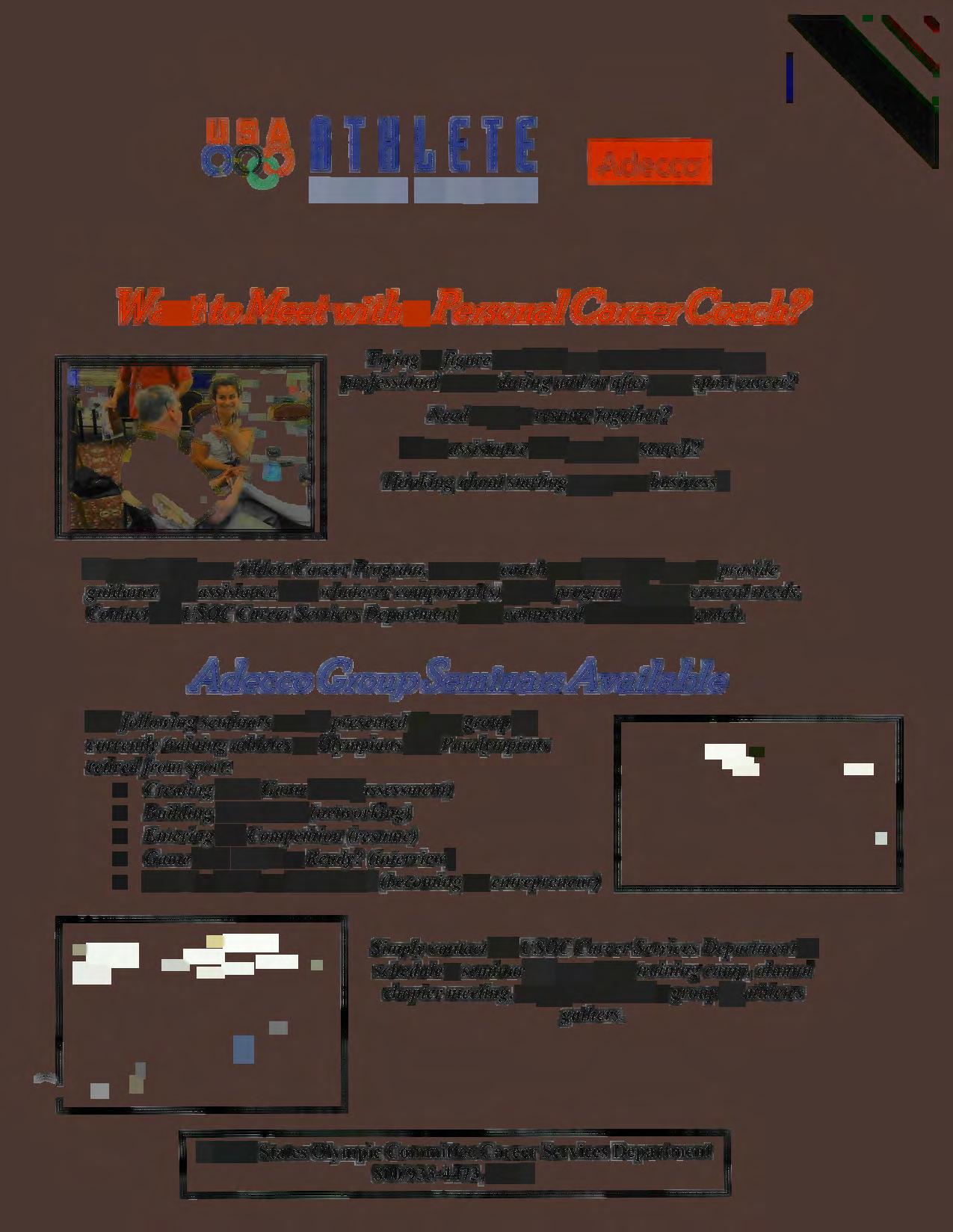
Want to Meet wit.ha Personal Career Coach.?
Trying to figure out what you want to do with your professional career during and/or after your sport career?
Need to get a resume together?
Want assistance with your job search?
Thinking about starting your own business?
As part of the new Athlete Career Program, a career coach can work with you to provide guidance and assistance with whatever component(s) of the program fit your current needs. Contact the USOC Career Services Department to he connected with a career coach.
Adecco GroupSeminarsAvailahle
The following seminars can be presented to any group of currently training athletes or Olympians and Paralympians retired from sport:
• Creating Your Game Plan (assessment)
• Building Your Team (networking)
• Entering the Competition (resume)
• Game On! Are You Ready? (interview)
• Can You Be Your Own Boss? (becoming an entrepreneur)
Simply contact the USOC Career Services Department to schedule a seminar for your next training camp, alumni chapter meeting, or any other time a group of athletes gathers.
OLYMPIANS TAKE CENTER STAGE AT THE 2006 ESPYS WITH 12 ATHLETES HONORED AND 24 NOMINATIONS
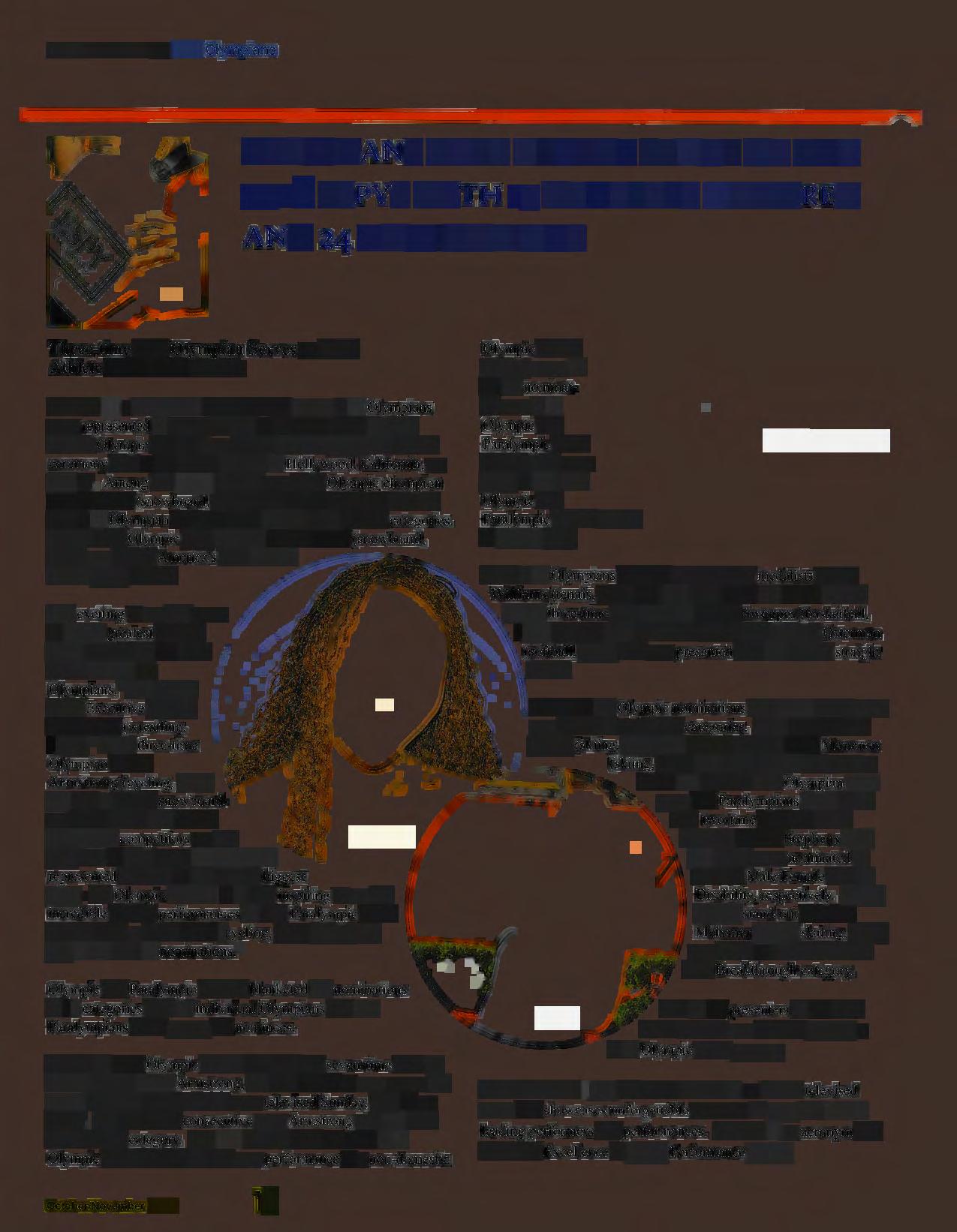
Three-time U.S. Olympian Serves as First Athlete Host of the ESPY s
Selected by a record 12.1 million online voters, U.S. Olympians were represented in strong fashion at the 2006 ESPY Awards. Twelve Olympic athletes were named winners during the awards ceremony held at the Kodak Theater in Hollywood, California, on July 13. Among this year' s winners was 2006 Olympic champion Shaun White (snowboard, 2006), who earned honors in both the Best U.S. Olympian and Best Male Action Sport Athlete categories. Fellow 2006 Olympic gold medalist Hanna Teter (snowboard, 2006) was named America's Best Female Action Sport Athlete.
"It's exciting to see that some of sports' greatest athletes being honored by the 2006 ESPY Awards are Olympians," said USOC Chief Executive Officer, Jim Scherr (wrestling, 1988)." From three-time Olympian Lance Armstrong (cycling, 1992, '96, '00) to Torino snowboarders Shaun White and Hanna Teter, these competitors are not only stars in their sport, but they have represented America on the world's biggest stage - the Olympic Games. It is also inspiring to see the incredible athletic performances of U.S. Paralympic Team athletes such as Steve Cook (cycling, 1996, skiing, '02, '06) in the field of nominations."
Olympic and Paralympic athletes blanketed the nominations in 15 categories with 24 individual Olympians and two Paralympians listed among the nominees
Hosted by 2000 Olympic bronze medalist and seven-time Tour de France winner Lance Armstrong, the first athlete to ever emcee the event , the 2006 ESPY Awards were televised Sunday, July 16 on ESPN. For the fourth consecutive year, Armstrong won the Best Male Athlete category Just five months after the 2006 U.S. Olympic Team boasted its best ever performance at a non-domestic
Olympic Winter Games, seven of the 24 nominated were U.S Olympic and Paralympic Team athletes who competed in the 2006 Olympic and Paralympic Winter Games in Torino, Italy.
Other U.S. Olympians honored included gold medalists Venus Williams (tennis, 2000, '04) who took home her fourth overall ESPY, three-time gold medalist Sheryl Swoopes (basketball , 1996, '00 , '04) who earned her third ESPY and Cat Osterman (softball, 2004) who was presented with her second straight award
White led the Olympic nominations with three , while Teter was named in two ESPY categories. Gold medalist Ted Ligety (skiing, 2006) and bronze medalist Julia Mancuso (skiing, 2002, '06) joined White and Teter to round out the Best U S. Olympian category, and Paralympians Steve Cook and two-time gold and silver medalist Laurie Stephens (skiing, 2006) were nominated as the Best Male/Female With A Disability, respectively Figure skating stand-out Kimmie Meissner (figure skating , 2006) was listed as a nominee in the Best Breakthrough category.
One of the presenters of the 2006 ESPY Awards was General Motors, a U.S. Olympic Team sponsor.
First awarded in 1993, the ESPY Awards is an annual televised event that showcases unforgettable moments in sport and salutes leading performers and performances. "ESPY" is an acronym that stands for Excellence in Sports Performance Yearly.
THE USOC SELECTS
2005 COACHES OF THE YEAR
2005 United States Olympic Committee
National Coach of the Year Eddie Reese (USA Swimming) , the head men's swimming coach at the University of Texas, saw his athletes combine to break three world records in 2005 , with Aaron Peirsol (swimming , 2000, '04) surpassing ~ is own marks in the I 00m and 200m Jackstroke and Ian Crocker (swimming, 2000, '04) snapping his own 100m butterfly record. Reese was named the World Swimming Coaches Association 2005 Terao Award winner, [naming him the coach of the 2001-04 quadrennium.] Reese coached seven swimmers that accounted for nine medals (eight gold and one silver) for the U.S. at the 2005 World Championships.
2005 USOC Developmental Coach of the Year Tammy Gambill (U.S . Figure Skating) coaches many national and international figure skating competitors and medalists including Dennis Phan , the 2004 Junior Grand Prix Final champion, and three 2005 U.S. Figure Skating national champions (juvenile girls, novice men and junior ladies) In addition to her coaching, Gambill is the current chair of the U.S. Figure Skating Coaches Committee , member of the Professional Skaters \ssociation's Board of Directors, and past member of the U.S. Figure Skating Board of Directors. She is also a member of the U.S. Figure Skating Athlete Development

Committee and Sports Sciences and Medicine Committee.
2005 USOC Volunteer Coach of the Year Cindi Hart (U.S . Speedskating) is the speedskating head coach for the IndySpeed Sport Club and runs the speedskating program for the entire state of Indiana , both for U.S. Speedskating and Special Olympics, Indiana In 2005, Hart coached two members of IndySpeed to second place finishes in the national championships, the best ever performances for speedskaters from the state of Indiana. As speedskating head coach for the Special Olympics, Hart (who was diagnosed with breast cancer in May 2004) took Team USA to the World Winter Games in Nagano , Japan, and coached the team to a. best-ever performance with 26 of the 27 athletes winning medals. She also wrote speedskating training programs and training manuals for the Special Olympics . Using cycling as a. summer conditioning program , she coached five athletes to national medals, including two national champions and multiple state champions
2005 USOC National Paralympic Coach of the Year Randi Smith (U S Paralympics),
the head coach of the U.S. Paralympic Archery Team 2005-present, coached the U.S. team at the 2005 World Paralympic Championships in Italy. She served as the U.S. Paralympic Archery Team Leader at the 2004 Olympic Games in Athens, Greece In 2002 she was nominated by USA Archery for the USOC Developmental Coach of the Year a.ward. Smith has been the co-owner of Salt Lake Archery since 1985 and coaches the Utah Hot Shots. She also works as a Crisis Family Therapist for Salt Lake County Youth Services.
Also honored during the June 23 Night of Champions event in La Jolla., California, was Dr. Kyle Pierce (USA Weightlifting), who received the "Doc Counsilman Science Award. Dr. Pierce has consistently used various aspects of sports science to further the performance and ensure the health of young weightlifters. His innovative training techniques, developed over 30 years of involvement in the sport are now used by many coaches. These methods have included creative periodization and athlete monitoring processes . He has studied aspects of body composition, power output, and rate of force development along with many other studies He has developed a. state of the art laboratory at LSD-Shreveport to continue his research into improving the sport and science of weightlifting
ALUMNI NEWS
IN HONOR
Thousands auditioned, but only the final twelve got to live together on the Queen Mary and vie for an exclu-
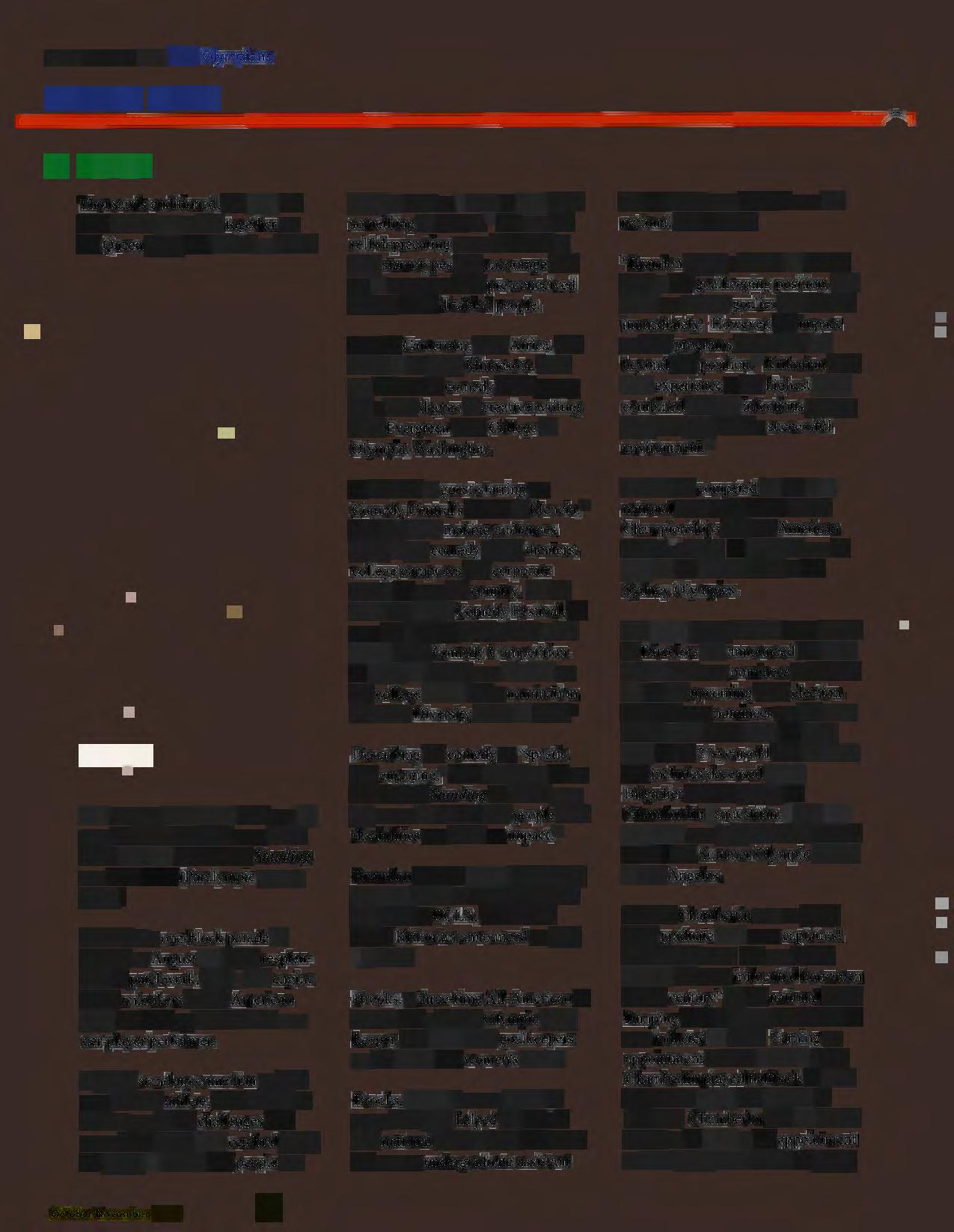
sive contract with NBC And one by one, the twelve finalists were voted down until the Last Comic Standing was Josh Blue (Paralympic soccer, 2004)!
Treated to a one-block parade in Denver on August 21, Blue, resplendent in patchwork, rode a fire engine while onlookers waved American flags and held up masks of the soccer-player/performer.
A gifted stand-up comedian as well as a talented athlete , Blue refuses to bow to any of the challenges that come from living with cerebral palsy. He jokes , "I realize that people are
going to stare so I want to give them something to stare at." He uses his self-deprecating sense of humor to defy stereotypes and encourage others to overcome their pre-conceived notions about disabled people
Born in Cameroon, West Africa , and raised in St. Paul, Minnesota, Blue got his st art in comedy while pursuing a B A. degree in creative writing from Evergreen State College in Olympia, Washington.
In addition to g uest-starring on Comedy Central's "Mind of Mencia ," Blue has been making audiences laugh in top comedy clubs, theaters, college campuses and corporate events all over the country. At the 2004 Las Vegas Comedy Festival, he won the $10 ,000 Grand P_ri ze at the Royal Flush Comedy Competition In 2005, he earned rave reviews on the college circuit and a nomination for " Best Diversity Event of2006 "
Describing his comedy as "spastic and engaging ," Blue wanted to be on Last Comic Standing to "make people aware of the fact that people with disabilities can make an impact."
Brandon Brooks (water polo , 2004) has been added to the Bruins' water polo staff at UCLA , head coach Adam Krikorian announced on July 19, 2006.
Brooks, a three-time All-American at UCLA and a former Olympic goalkeeper, will work with goalkeepers on the men's and women's teams.
Brooks , UCLA's career leader in saves with 700 , helped the Bruins win national titles in 1999 and 2000 . He was an undergraduate assistant
for the men's team when it won the national title in 2004 .
"Brandon brings a wealth of knowledge to the goalkeeping position, and a ll of our current goalies will benefit immediately. However, his impact on both programs will extend far beyond that position, " Krikorian said " His experience at the highest level, combined with his infectious personality, will help foster a successful environment."
Brooks has competed for the U.S. national team at the FINA World Championships and Pan American Games in 200 3 In 2004 , he was in goal for the United States at the Sydney Olympics.
The Elgin Sports Hall of Fame Board of Directors has announced the addition of nine new nominees to the ballot for the upcoming 2006 election. The nine new nominees are the most added to the ballot since the early days of the 27-year-old Hall of Fame and includes deceased Army Brigadier General Harry D. Chamberlin (equestrian , 1920, '28, '32), who won gold and silver medals at the 1932 Summer Olympic Games in Los Angeles.
General Chamberlin was an Elgin High graduate who once captained the football te am. He was called "one of the most influential horsemen of this century" by the national Show Jumping Hall of Fame, into which he was inducted in 1990. Earning an appointment to West Point in 1906, Chamberlin pl ayed halfback in football for the Army and lettered in 1907-08. Chamberlin had not ridden horses at all prior to his appointment to West Point, from which he gradu-
ated in 1910, yet he became argu ably the finest rider the Army ever produced . He went on to participate successfully in three Olympic Games , competing in all three disciplines of show jwnping, dressage and Three-Day Eventing Chamberlin won the individual silver medal in jumping and a team gold medal in Three-Day Eventing during the '32 Games.
William D. (Bill) Havens, Jr. (canoeing , 1936 , '40, '44 , '48) was inducted into the Arlington Sports Hall of Fame on May 31 , 2006.

Havens is one of the most outstanding canoeists ever in the United States He was a natural in the sport. Havens is the son of the late and famous canoeist, Bill Havens , Sr. , nephew of Olympian Charles Havens (canoeing, 1924) and brother of Frank Havens (canoeing , 1952) , an equally famous canoeist and Olympic gold medalist. Havens was born in 1919 and grew up in Arlington , Virginia. He became an Arlington eler""" mentary school teacher and served for nany years in the Arlington County system as an elementary school principal, a position from which he eventually retired. He was an outstanding athlete in high
school and college at George Washington University. He excelled in several sports (football, boxing, track, swimming, and wrestling) and gained national prominence in canoeing at the age of 16, winning his first national canoe tilting title and finishing third in the Olympic trials for single-blade canoe. He was named to his first of four Olympic teams in 1936 as an alternate and was named to the three following Olympic teams as a member.
Havens went on to win 19 more National Championships , including 12 National Championships in canoe tilting. Beginning in 1936 , when he was a high
very next day. school junior, through 1953 he dominated the sport. He was undisputed champion and defended his canoe tilting title over 500 times. He was defeated only once, and that by his brother Frank in 194 7 at the American Canoe Association regatta held at Sugar Island on the St. Lawrence River. He regained the title by defeating Frank the
Though he was named to both the 1940 and 1944 Olympic teams, those Games were not held because of World War II. In 1948 Havens again made the Olympic team, finishing fifth in the single-man canoe race at the London Games. Following the '48 Olympic Games, Bill and his brother Frank set as their goal to win the two-man canoe race at the 1952 Games in Helsinki . After an intensive training regimen and excellent competitive race results , they were favored to win the two-man event. But a freak accident severed the tendons in Havens' hand, and
he was denied that last opportunity to win an Olympic medal. His brother Frank went on to win silver and gold in Helsinki.
Despite the serious injury, Havens was far from finished as a competitive canoeist. After regaining most of the use of his injured hand, he continued competing for many more years, into his 80s, racing in national and international regattas, setting records and winning many more gold, silver and bronze medals in Senior and Master canoeing and kayaking events In an interesting twist of fate , in the late 1980s , Bill and Frank Havens found themselves at a World Masters race in Canada lined up next to the winning Olympic team from the 1952 race they had missed due to Bill's injury; the Havens brothers won the event by a large margin . In 1999, Havens was inducted into the American Canoe Association Legends of Paddling Hall of Fame. Now 87, Havens lives with his wife, Ginny, in Williamsburg, Virginia.
USA Hockey hired Mark Johnson (ice hockey, 1980), the successful college women's coach, to lead its women's national team as the program undergoes substantial change .
Johnson , who scored two goals in the "Miracle on Ice" win against the Soviet Union en route to 1980 gold, will lead the national team in the 2007 Women's World Championships, scheduled for April 3-10 in Canada. He directed the Wisconsin women's team to its first NCAA championship in 2005-06. He was assistant coach with the 2002 and 2000 U .S . men's world championship tournament teams.
Carolyn Kruse, a Colorado Springs , Colorado resident since 1963, after finding the city in the library at Washburn University in Topeka, Kansas, is one of
ALUMNI NEWS

the city's unsung heroes in philanthropic and community sports contributions. She was recently named the winner of the 2006 William Thayer Tutt Sportsman Award, an award presented annually by the Colorado Springs Sports Corporation to an individual in recognition of exceptional philanthropic and community sports support, [as well as on the national sports stage.] Kruse will be honored at the Sports Corporation 2006 Colorado Springs Sports Hall of Fame Banquet and Induction Ceremonies on October 25, 2006, at the World Arena.
She is the third winner of the award , named for the legendary, visionary sportsman and civic giant who helped to transform the city into a world-class center for national and international events . Tutt cultivated the Broadmoor into a sports mecca over four decades, making it the host for world championships in figure skating and ice hockey, the first ten NCAA ice hockey championships and numerous U.S. Golf Association amateur championships. He was also a driving force in the city's efforts to bring the United States Olympic Committee to the city in 1978 , along with its flagship training center and more than 25 National Governing Bodies of Olympic and Pan American Games sports.
Kruse has dedicated more than four decades of service and personal support to sports in the Pikes Peak Region . She has served as a prominent official with the U.S. Figure Skating Association, helped to plan the Colorado Springs World Arena , volunteered at the first three USOC National Sports Festivals, served as a team leader for the USA Figure Skating delegation at the 1998 Olympic Winter Games, and has served on the Boards of the World Arena and The Sports Corp. There is almost no
sports event staged in the city that she has not been a part of as a volunteer or organizer, and she and her husband, Clif, have been generous with their financial support of the sports community.
In 2000, Kruse was honored with the Col. F. Don Miller Award for her lasting contributions to the Colorado Springs sports community. The Women's Sports Foundation honored her in 1990 with its Recognition Award for Outstanding Service in Women's Sports.
25-year-old enjoyed her best season to date last year, capturing her first-ever individual medal, bronze , during a November Challenge Cup series stop on the 2006 Olympic course, in Cesana Pariol, Italy, and also helped guide USA Luge to a pair of World Cup team event medals. Zablocki also finished a U.S.best ninth in the final 2006 World Cup rankings, before racing to USA Luge's best-ever women's singles Olympic result, fourth.
Preston Griffan (luge, 2006) and Dan USA Luge Association named its 2006 Joye (luge, 2006) won their first-career Athletes and Team of the Year.
For the third consecutive year and fourth time overall, Tony Benshoof (luge, 2002 , '06) won USA Luge's Male Athlete of the Year Award Before finishing fourth in February's men's singles Olympic luge race, Benshoof slid to both the 2006 overall Challenge Cup silver medal and 2006 overall World Cup bronze medal and a career-high 12 international podia. The 31-year-old also became the association's all-time singles leader in international medals won, with 30 Courtney Zablocki (luge , 2002 , '06) captured her first-career USA Luge Female Athlete of the Year honor. The
USA Luge Team of the Year Award together. The pair slid to a career-best fifth place World Cup finish on the 2006 Olympic course before finishing 10th in the final overall World Cup doubles rankings Griffall and Joye also slid to , U.S.-best eighth place finish at the Olympic Winter Games.
Erin Hamlin (luge, 2006) pocketed her third consecutive Junior Female Athlete of the Year Award. During February's Olympic Winter Games, the 19-year-old slid to a 12th place finish. Prior to her first Olympic competition, Hamlin completed her first season on the senior women's singles World Cup tour ranked
12th overall, before she guided USA Luge to a bronze medal in the junior (to age 20) world championship team competition.
Andrew Pettigrew (athletics , 2000) was named the sprints, hurdles and relays coach at the University of North Carolina, head coach Dennis Craddock announced in mid-July.
Pettigrew is a 1992 graduate of St. Augustine's College in Raleigh , North Carolina, and an Olympic gold medalist in the 1,600-meter relay. A five-time world champion and a former world record holder in the 4x4, Pettigrew was a 10-time All-America performer and fourtime Division II NCAA champion in the 400 while at St. Augustine's.
fl n addition to his Olympic and world championship titles, Pettigrew is a fivetime U.S. champion in the 400 meters over a span of 12 years. His first title came in 1989 , just two years after graduating from high school, and his last came in 2001.
He comes to Carolina from Cardinal Gibbons High School in Raleigh, where he spent the last three years as director of cross country and track and field Under
his leadership, Cardinal Gibbons won state championships in both boys and girls track and field and boys and girls cross country. Prior to 2003, Pettigrew spent three years as an assistant at St. Augustine's. While there, he coached 30 All-America performers and helped lead the men to a NCAA title in 1996 and the women to a NCAA championship a year later.
USA Women's National Volleyball Team Head Coach "Jenny" Lang Ping was presented with the Fair Play Mecenate 2006 award on June 3, 2006, at Cortona, Italy.
"I was surprised to hear that I was selected for this award," Lang Ping said. "The award is huge in the world with many great people having been selected. It distinguishes people as a player and a coach."
In its 10th year, the award is organized by the County of Cortona, the Province of Arezzo, the Trade House of Arezzo and the Agency for Tourism of Arezzo. The

award was created following the 1985 disaster in which 39 fans tragically lost their lives during a soccer game at Brussel's Heysel Stadium The award recognizes individuals who exhibit sport ethics using social civility for reinforcing the values of sport. It recognizes outstanding individuals and national institutions for their initiatives, which connect sport and civil society.
Not only was Lang Ping present to accept the award , but several other worldwide sport celebrities were on hand
" I watched many of these people on television , and now they were at this ceremony, " Lang Ping said "I feel lucky to have been able to meet all these great athletes."
ALUMNI NEWS
MILESTONES
Andre Agassi's (tennis, 1996) voice wavered and his eyes welled up , as he announced that he would retire after the 2006 U.S. Open , leaving tennis after two decades during which he collected a

career Grand Slam and morphed from an "Image Is Everything" youngster to elder statesman.
Agassi said he made up his mind early in the year to leave at the end of 2006, but he wanted to make it public at the All England Club , where he won his first Grand Slam title. So there he sat at the end of June, a father of two with a shaved head wearing an all-white track suit , choking up as he discussed hi s decision
His 1992 Wimbledon victory over Goran I vanisevic changed the course of his career ; it was a tournament he'd avoided as too traditional for his outlandish persona and because he felt his baseline game wasn't the prototypical path to success on grass.
Agassi has won 60 singles titles, including eight at Grand Slam tournaments - he's one of only five men with at least one
championship at each. His rivalry with Pete Sampras helped boost tennis' popularity in the 1990s; Agassi is the last active player from their tremendous generation of American men, a group that also included major champions Jim Courier and Michael Chang
A magician at the baseline and one of the game's greatest returners , he was ranked number one as recently as May 2003, at 33 the oldest man to hold the top spot. He made a stirring run to the U .S. Open final last year, the seventh time he was the runner-up at a major. He missed Wimbledon the past two years because of injuries.
Agassi turned pro in 1986, reached his first major final at the French Open in 1990, and quickly drew attention for his tennis togs and 'tude; his celebrity was such that his two-year marriage to Brooke Shields and friendship with Barbra Streisand were fodder for the tabloids. Along the way, his "Image Is Everything " ad campaign for a camera company fostered a sense he was more about style than substance; years later, he distanced himself from the slogan.
He rose to the sport's apex, reaching No. I in 1995. Shortly thereafter, he went through a dry spell so dismal that he dropped out of the top 100 and resorted to playing in tennis' minor leagues. Then came his remarkable renaissance , thanks in part to a rigorous training regimen. In 1998 , Agassi made the biggest one -year jump into the top 10 by moving up 122 spots to No . 6. The next year, he won the French Open to complete his career Slam.
Agassi has won more than $30 million in prize money and collected millions more in endorsement deals; his charitable foundation has raised more than $50 million. The Andre Agassi College Preparatory Academy is a charter school for at-risk youth in his hometown of Las Vegas
He married 22-time major champion Steffi Graf in 2001; they have two children.
Aerials champion Eric Bergoust (skiing, 1994 , '98, '02, '06) has retired from competition after the most successful aerials career in international history - 16 years

on the World Cup tour, four Olympics, four world championships and 15 World Cup victories .
The emphasis has shifted from planning big jumps to a different kind of jump : he married Sally Jo Beck on July 22 in his hometown of Missoula, Montana. They were childhood friends and have been together for six years.
Bergoust was an ardent trampoline fan as a youngster, but when he saw aerials footage on ESPN in 1985, he found a new sport. He was the first person through the gate at the 1988 Olympics in Calgary, where aerials was a demonstration event. That summer he moved to Lake Placid on his own and was all but adopted by the U.S. coaching staff. He won the NorAm terials title that season and was on his way.
One of the most intense competitors, he would go on to collect the silver medal at the 1997 World Championships in Nagano, Japan , then come back a year later to win the 1998 Olympic aerials gold medal in Nagano. He also was the aerials gold medalist at the 1999 World Championships, and was a three-time World Cup champion - 2001 and '02 in aerials plus the overall title in '02 .
At one point, Bergoust owned the three highest scores for an aerials event in history.
"He did it all," said U.S . Freestyle Team Head Coach Jeff Wintersteen. "It's been fun being around him because he was such a professional , such a hard worker always looking to do more than the coaches wanted him to do. They'd be ooking for him to pull back and 'Bergy' would want to do more. And he was a good teammate, which is so important. His record, of course, speaks for itself.
We certainly wish him the best."
He doesn't have a "single greatest moment" in his career, but any list would include his first Olympics (1994 in Lillehammer, Norway, where he was seventh), the '98 Olympic gold medal in Nagano , and a "Bumps&Jumps" contest at California's Heavenly resort (also in 1998) when he won after completing five outstanding jumps Another favorite was any competition in Meiringen, Switzerland, site of the 1999 World Championships.
"I won every time I competed in Meiringen - two World Cups and at Worlds," he said. "I usually felt pretty good when we were there."
What a pedigree! Dylan Casey (cycling, 2000) and Jessica Greico (cycling, Pan American Medalist , World Championship medalist and World Junior Champion) are the proud parents of a son, Cole Walker Casey, born January 17, 2006, weighing 8 pounds , 1 ounce and 21 inches long Cole was born at Stanford Medical Center in Berkeley, California. Cole's middle name , " Walker," derives from Dylan's grandfather, Johrtny Walker, a fighter pilot in World War II Jessica's dad , Alan , was a member of the 1964 U.S. Olymp ic Cycling Team in Tokyo. Dad Dylan, a California native, is President of the U.S. Pro Cycling Board and a USA Cycling Board member, as well as a marketing executive with Google Corporation. Mom Jessica, a New Jerse y girl, is a practicing litigation attorney in New Jersey, New York and Pennsylvania. Jess ica will tend to motherhood duties while studying for the California Bar exam. The families live in Palo Alto , California. Jessica is also a part-time television commentator for major cycling events, having covered the 2000 Olympic Games in Sydney for NBC
and The Tour de France for Outdoor Life Network.
You are going to need a changing table in the bullpen for the USA Softball National Team
Lisa Fernandez (softball, 1996, '00 , '04) became a mom on December 19, 2005 , when her first child , Antonio Mayo, was born
And Jennie Finch (softball, 2004) has given birth to her first child as well, with son, Ace Shane Daigle , arriving on May 4, 2006, weighing in at 8 pounds, 10 ounces and 21 inches long. The boy's name makes sense , since Jennie and husband Casey Daigle are both superstar pitchers
Olympic medalist Liz McIntyre (skiing, 1992, '94, '98) is retiring as U.S. Ski
ALUMNI NEWS

Team moguls technical coach, a job she took shortly after retiring from competition in 1998 , following more than a decade of World Cup skiing. Athletes praised her selflessness: "It's always been about the athletes ."
"It'll be quite new, having nothing to do with skiing," McIntyre said, "but I've been doing it for a really long time, and I ,.
skipped the 1990 season, and when she returned, McIntyre skied the best of her career, earning a spot on three Olympic teams.
She led the qualifying run at the 1994 Olympic Games, and then collected the moguls silver medal in Lillehammer. She also competed in three world championships, just missing the medals podium in 1989 in Oberjoch, thenWest Germany, when she finished fourth. She teamed with Donna Weinbrecht (skiing, 1992) and Ann Battelle (skiing, 1992, '94, '98, '02) to form their sport's " Big Three" in moguls for much of the 1990s.
my teammates, and I will always appreciate the successes we had together. I really never imagined that my international career would last this long, and I am very grateful for the opportunities over the last 11 years. I want to thank everyone in the U.S. Soccer family, and particularly the fans, for all the support over the years. It has made my natio nal team career very, very special."
A perennial anchor of the U.S. defense for nearly a decade , he is the first three-time World Cup veteran to play his entire professional career in Major League Soccer. Pope ends his international career tied with Kasey Kell er and Claudio Reyna for the most-ever World Cup qualifying appearances in U.S. history, playing in 31
think it's time for me to do something else in my life. I'm not sure what that will be, but it's time to let someone else come in and work with everyone."
" Liz has been such a real blessing for us and did such an outstanding job. But she's been through two Olympic cycles , and she wants some time for herself, and Liz doesn't have to apologize for anything . We're stoked because we've been able to have her working with our athletes this long," said head coach Jeff Wintersteen (skiing, 1992)
McIntyre, 41, won four World Cup events and produced 18 other podium results during 11 seasons on the U.S . Ski Team. She competed in her first Worlds in 1986 while a sophomore at Dartmouth College ,
Sean O'Neill (table tennis , 1988, '92) and his wife, Elizabeth Le , announce the birth of their first child, Kaitlyn T. O'Neill on July 2, 2006, in Portland, Oregon. O'Neill is the current lead coach for U.S Paralympic Table Tennis and was named 2005 USOC Coach of the Year for Table Tennis at the national level. O'Neill recently joined the Board of Directors of the Oregon Chapter of Olympians (Oregon Sports Action) and is also the coach of the 2006 Cadet Junior Table Tennis team.
U. S. National Team defender Eddie Pope (soccer, 1996) has announced his retirement from international soccer, concluding an 11-year international career that included nine World Cup matches played since 1998 and 92 appearances overall.
"After having the opportunity to play in my third World Cup and taking some time to reflect with my family, I felt like it was the right moment to say goodbye to the national team ," said Pope. "I'll miss all
matches during three qualifying campaigns. He turned in one of the standout performances for the U.S . defen se at the 2002 FIFA World Cup , starting all five matches.
"Eddie ha s been the measuring stick for defenders in this country for nearly a decade," sa id U.S Soccer President Sunil Gulati. "As a member of three World Cup teams and the 1995 Olympic team, he has provided many memorable moments to spotlight the class he brings to an often underappreciated position . Eddie is an inspiration to young soccer play ers across the United St a tes, and will continue to inspire throughout the rest of his professional career."
beginning with D.C United in 1996 A three-time MLS champion, his greatest professional moment came when he scored the game-winning goal in overtime to give D.C. United the inaugura l MLS Cup title in 1996. Selected for the AllStar game in each of his 11 seasons , the Real Salt Lake defender was named to the league's All-Time Best XI last year.
Dane Spencer (skiing, 2002) seldom thought of skiing in the months since he broke his pelvis and his neck in a downhill race in Montana May changed that. That was when Spencer was cleared to walk without support for the first time since the near-fatal crash February 14 at Big Mountain in Whitefish, Montana.
DANE SPENCER
Pope recorded eight goals for the United 5tates , none bigger than his strike in the USA's 2-2 World Cup qualifying draw with Mexico on April 20 , 1997 He also scored the game -winner aga inst Mexico on April 28, 2004 , in Dallas , and added two goals to his account in 2006, netting in back-to -back games against Norway and Japan. The 32-year-old collected a Gold Cup championship medal in 2005. Now the 28year-old Spencer " Eddie Pope is arguably the finest defend- is awaiting final er this country has ever produced," said former U.S National Team Manager Bruce Arena. "I've worked with Eddie since our days with D C United and the Olympic team in 1996, and it has been a ple asure to watch him develop into such a class act, both on and off the field Eddie has always let his play do the talking, serving as a role model for a generation of defenders. I'd like to thank Eddie for his contributions to the program, and wish him and hi s family the best for the future."
Pope has spent his entire 11-year professional career in Major League Soccer,
clearance from doctors to see if he is healing properly. He hopes to follow the path of skiers like Hermann Maier of Austria and Brian Stemmle of Canada, who returned to racing after career- or life-threatening injuries.
" There are some things in ski racing that are very important to me that I still want to achieve, " said Spencer, who has scars on his forehead from the halo device that held his head in place after the crash. " I'll do it again. I'll probably do it a little differently, but I can't say how. "
After early-season results kept him from
winning a spot on the 2006 Olympic squad, Spencer chose to hone his skills for the rest of the World Cup season with the downhill at Big Mountain . While buckling his boots for his run, his coaches told him that a teammate, Ted Ligety (skiing , 2006), had just won an Olympic gold medal.
Two minutes later, Spencer was in a heap in the snow, bleeding internally after a faulty landing. Racing to save his life , doctors gave him five units of blood and put him in a coma. When he awoke days
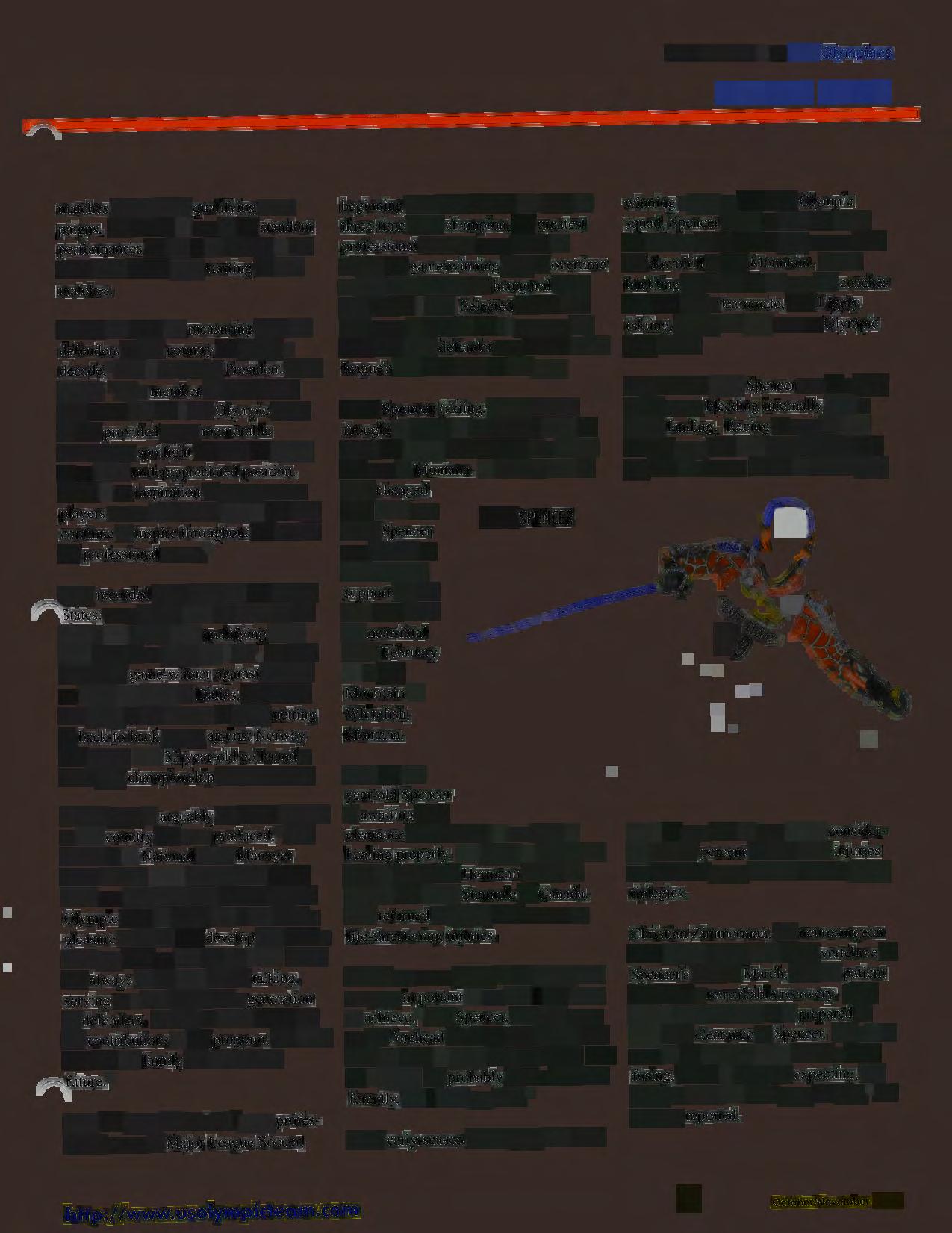
later, he was told he was lucky, considering that 80 percent of such neck injuries are fatal and many victims become quadriplegics.
Christian Zimmerman, the neurosurgeon from Boise, Idaho , who fused vertebrae in Spencer's neck in March , said his patient had made a remarkable recovery. Still , weeks remain before he is prepared to give final clearance to Spencer. "If a C .T. scan of his cervical spine shows a solid fusing , which is what I'm expecting, I'm going to le a ve the door open for him ," the surgeon reported.
A doctor's visit in
ALUMNI NEWS
IN MEMORIAN
Wilson D. "Buster" Charles (athletics, 1932) passed away on June 6, 2006. Charles was the USA National Decathlon AAU Champion in 1930. Though he broke his back in 1931, he recovered in time to make the 1932 Olympic team and placed fourth in decathlon. Charles was a member of the Oneida Nation .
George Freon (athletics, 1972) was born in San Fernando, California, on December 26, 1941, and passed away in Sacramento on June 26, 2006, at the age of 64. Frenn was an amateur athlete from 1959 to 1978, appeared on the cover of Sports Illustrated on July 6, 1970, and held world records in the 35-pound and 56pound weight throws. He had recently retired after 32 years teaching science m several California high schools.
Winning a silver medal in the Olympics would cap the career of most athletes. For Andy Sudduth (rowing, 1988), widely regarded as one of the finest rowers the United States ever produced, it was an inspiration to keep racing .
"It wasn't that we didn't win," he told The New York Times a few months after taking home a silver medal from the Los Angeles Games, where his crew of eight
narrowly missed the gold in 1984. "We didn't show up with our best performance that day. I said in August I came half a second from retiring."
With his lanky, 6'3" frame, curly blond hair, and a list of successes that seemed to grow each time he dipped oars into water, Sudduth was a star of the rowing and sculling circuits in the 1980s. He was on eight national and Olympic teams and was a medalist four times at the World Rowing Championships. His name is legendary at the Head of the Charles, where he won singles events in five consecutive regattas.
Sudduth, who on dry land helped develop server technology that became part of the Internet's foundation, died of pancreatic cancer on July 15 at his family's summer home in Marion, Massachusetts. He was 44, and in recent years had turned to long-distance bicycling, once pedaling 25 miles from his residence in Stow to Cambridge for a chemotherapy treatment.
"He was one of the best rowers in the United States and certainly one of the greatest Harvard oarsmen ever. He had quite an extraordinary record," Harvard men's rowing coach Harry Parker said. "He came to the sport with quite exceptional physical attributes . He was very, very powerful, had tremendous endurance, and also developed quite an exceptional skill at making boats go. You have to have all of those to succeed, and Andy did "
"He's physiologically a unique specimen," said Gregg Stone of Newton, a friend and former national champion "He also just
had a single mindedness, a real ability to focus on the task at hand."
Effortlessly moving from rowing to single sculling, Sudduth was a world-class athlete in both disciplines. In rowing, arguably the ultimate team sport , each crew member strokes with a single oar at precisely the same time. A single sculler is at the opposite end of the spectrum, as solitary as an athlete can be.
After leading the Harvard crew to the Grand Challenge Cup at Henley in England in the 1980s, Sudduth converted to sculling and was "instantly successful, getting a silver medal in the World Championship," Stone said.
Bringing the same passion to his work in • computers as he did to rowing, Sudduth helped develop servers that are used by a significant percentage of Internet providers . As with his rowing ability, his technical prowess emerged early when he set up his junior high school's first computer network in Exeter, New Hampshire , in the 1970s. And while working in a computer lab at Harvard in 1988 , he was the first to send out a major warning when the infamous Internet Worm virus circulated.
"He was technically one of the most brilliant people I ever worked with," said Brian Shorey, a friend who was Sudduth's boss at Cisco Systems Inc., where he worked until recently "His mind went a mile a minute, and it was tough to keep up with him "
Andrew Hancock Sudduth was born in Baltimore and grew up in Exeter. He
graduated from Philips Exeter Ac ademy, where he first started rowing , sometimes breaking the ice in March so he could begin training.
A brilliant student, Sudduth was known as
much for his practical jokes, such as booby-trapping cereal boxes with firecrackers , as he was for his high SAT scores and wide-ranging knowledge.
" You didn't want to play Trivial Pursuit
~ gainsthim
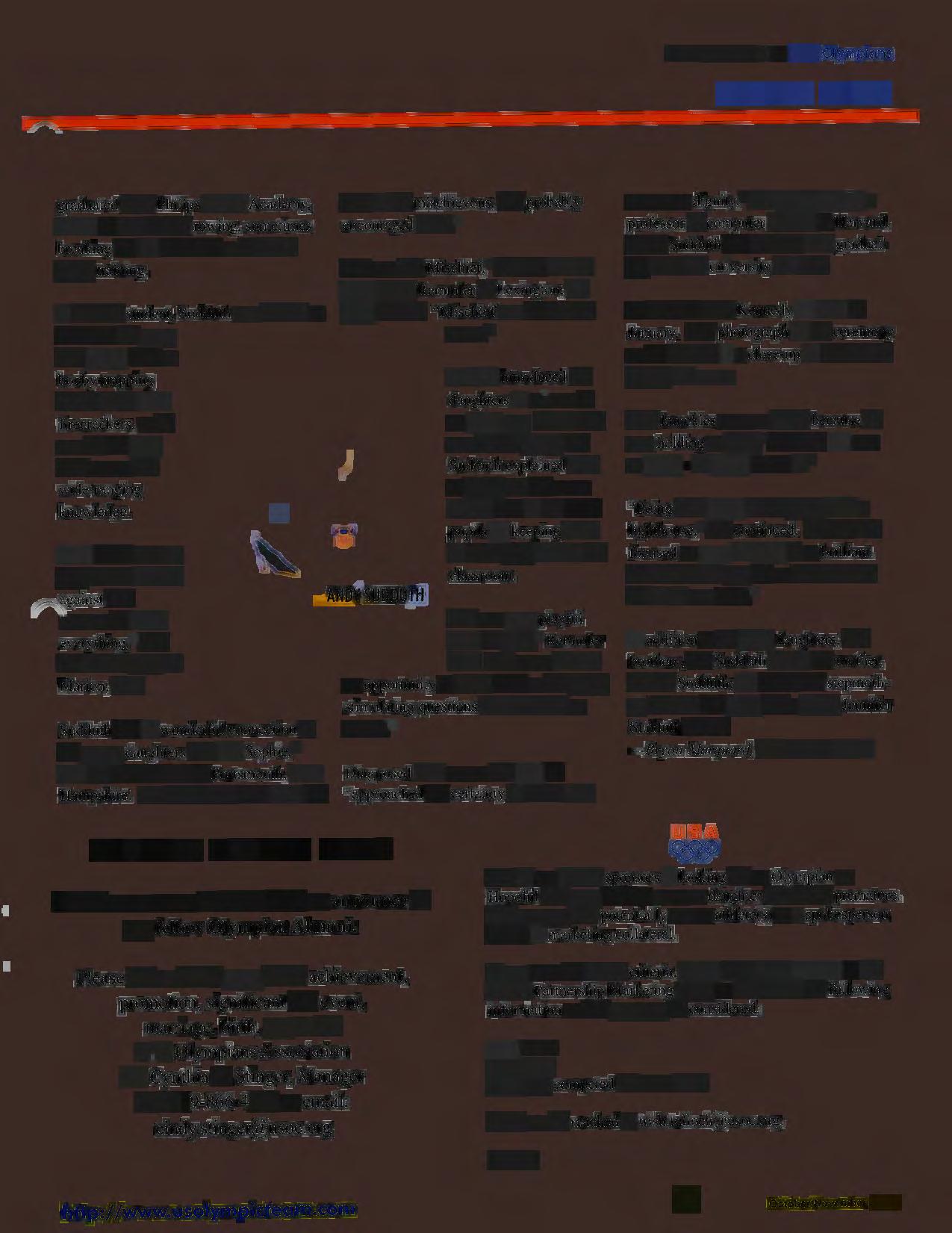
love of the mischievous, and probably encouraged them."
enormous dignity," said Harry Lewis , a professor of computer science at Harvard , where Sudduth had worked after graduating from the university in 1985.
"He was Mr. Mischief," said his former wife, Saiya Remmler of Lexington, the girls' mother. "Mischief was his middle He married Ruth Kennedy of Stow in January. One photograph of the ceremony on his website is a close-up of their hands during the vows.
name ."
He also introduced his daughters to science at an early age . When Zoe was in first grade, Mr. Sudduth explained how to figure out the mean arrival time of the other pupils by keeping track of when they entered the classroom.
"He was very playful with the kids," Remmler said. "He never missed
"His knuckles were so white because he was holding so tight," she said. "It was so Andy - he really meant it."
"Being with Andy is like being with a lighthouse," she continued . "When he's focused on you, the light is so brilliant. And when he's not, it's so dark because his focus was utter." >ecause he knew everything," said his brother Rob , of Marion, MA .
Sudduth had "a wonderful connection to
In addition to his wife, daughters, and brothers, Mr. Sudduth leaves his mother, Sharlie Sudduth; his father and stepmother, S Scott and Gail; and a sister, Jennifer Sudduth Walsh his young daughters Zoe and Sophie," ---Bryan Marquard, The Boston Globe said his brother Matt of Portsmouth, New Diagnosed with cancer last fall , he Hampshire. " He has shared with them the " approached the certainty of death with
an opportunity to teach them or ask really stimulating questions about science or nature ."
OLYMPIC ALUMNI NEWS
I have some news to share with or announce to my fellow Olympian Alumni:
Please fax or email your latest achievement, promotion, significant life event, marriage, birth, etc; to the U.S. Olympians Association
c/o Cynthia E. Stinger, Manager fax: 719-866-4 728 or email: cindy.stinger@usoc.org
USA
Q%)
One of our USOC sponsors is looking for an Olympian or Hopeful that gave birth to a son or daughter 4-5 weeks premature. This sponsor will potentially use an athlete(s) as a spokesperson and /or in marketing collateral.
If you meet the above criteria, please send Trish Tulloch in the USOC Partnership Marketing Dept. an email with the following information so that you may be considered:
your name your sport years you competed for team USA
Trish can be reached at trish.tulloch @usoc.org.
Thanks
U.S OLYMPIANS ASSOCIATION-51045
UNITED STATES OLYMPIC COMMITTEE
1 OLYMPIC PLAZA
COLORADO SPRINGS , COLORADO 80909-5760

1936 Olympic bronze medalist in swimming Alice Bridges celebrates her 90th birthday with family and friends
UNITED STATES OLYMPIC COMMITTEE BOARD OF DIRECTORS
USOC CHAIRMAN
Peter Ueberroth
Bob Ctvrtlik
Erroll Davis
Anita DeFrantz
Jim Easton
Jair Lynch
Mary McCagg
Jim McCarthy
Mike Plant
Dr. Harold Shapiro
Stephanie Streeter
USOC CHIEF EXECUTIVE OFFICER
Jim Scherr
U.S. OLYMPIANS OFFICERS
2005-2008
PRESIDENT
Willie Banks (athlet ics , 1980, ' 84, ' 88)
VICE PRESIDENTS
Anne Warner Cribbs (swimming, 1960)
Connie Paraskevin-Young (speedskating , 1980, '84/ cycling, 1988, '92, '96)
Carol Lewis (athletics , 1980, '84 , '88)
Dick Fosbury (athletics , 1968)
Micki King (diving, 1968 , '72)
Gary W. Hall Sr (swimming, 1968 , '72, ' 76)
HONORARY EXECUTIVE DIRECTOR
Dorothy Franey Langkop (speedskating, 1932)
IMMEDIATE PAST PRESIDENT
John Naber (swimming, 1976)
PAST PRESIDENT
Bill Toomey (athletics, 1968)
EDITORIAL STAFF
SENIOR EDITOR
Cynthia E. Stinger (team handball, 1984 , '88, '92)
ASSOCIATE EDITORS
Leah Chandler Mills
Christine Taylor
Chris Sebby
PRODUCTION DIRECTOR
Denise O'Shea - O'Shea Design
by: Getty Images & The USOC Library
36USC220506
